Sunday, September 11
This was a day of registration and setting up of the displays in the beautiful Charleville Raceview Complex, and of course meeting and catching up with old and new friends once more.
 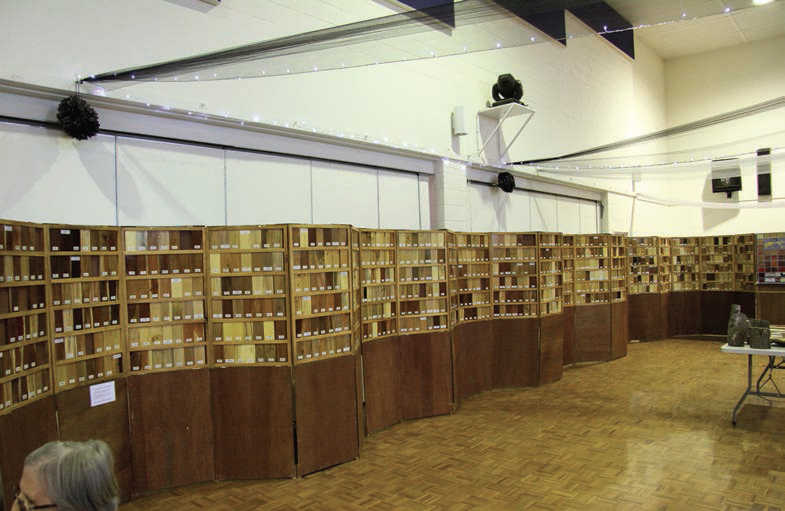
Some views of the display and layout — including 1008 specimens on the display boards in the main auditorium of the Charleville Racecourse. The facility
also included a kitchen and foyer which was used for wood turning demonstrations, plus other service areas.
Monday, September 12
Delegates split and alternated between the historic tour and doing a tour of Nick Swadling's property, travelling in four-wheel drive vehicles. In the evening we received a Welcome to Country. The Official Opening of the Conference was performed by the Mayor of Murweh Shire, Annie Liston.
Historic Tour
During WWII, the USA Air Force had a large contingent of service personnel spread along the Brisbane Line. Charleville was the location for the Air Force and was the main location of the Norden Bomb Site, a top secret early tracking system, which was housed in a concrete bunker which still stands. Today, Charleville is a major base for the Royal Flying Doctor Service, which uses a mixture of 20 Pilatus PC-12 and King Air, twin and single engine planes, which fly out of nine bases in Queensland.
 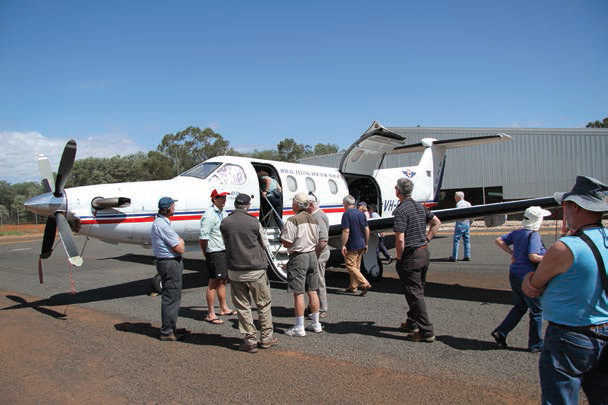
Concrete bunker used by USA Air Force in WWII Royal Flying Doctor PC-12 aircraft
Nick Swadling's Magpie Lane
During the tour of Nick Swadling's property, we identified the following species:
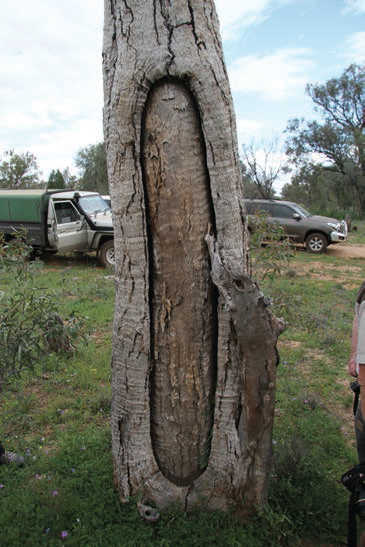 1. Eucalyptus melanophloia, silver-leaved stringybark
1. Eucalyptus melanophloia, silver-leaved stringybark
2. Codonocarpus pyramidalis, desert poplar
3 Acacia aneura, mulga
4. Eucalyptus populnea, poplar box
5. Acacia cambagei, gidgee
6. Petalostigma pubescens, quinine berry
7. Grevillea striata, beefwood
8. Corymbia clarksoniana, Clarkson's bloodwood
9. Eremophila mitchelli, false sandlewood
10. Corymbia tessellaris, Moreton Bay ash
11. Melaleuca leucadendra, river tea-tree
12. Acacia excelsa, ironwood
13. Owenia acidula, emu apple
14. Eucalyptus ochrophloia, yapunya.
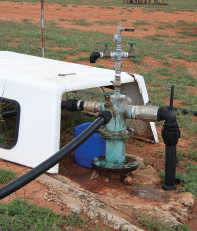
Photo Left - Water supply for the property comes under pressure from an Artesian well which is to control usage.
Photo Right - The Shield Tree - The bark of this tree was cut by Aborigines who used it as a shield many years ago.
Tuesday, September 13
Sommariva Olives and Maryvale Station - We set out by bus, and after an interesting visit to Sommariva, we had morning tea beside the bus halfway to Maryvale Station. There we were put into four wheel drive vehicles for a lengthy ride. We were again excellently catered for by Jenny and Robert Crighton with an outdoor, evening dinner before returning home and just beating a heavy rain storm. The Crightons were the original instigators of the meeting, and the success is hugely due to their excellent cooperation and encouragement.
During the tour of the property we identified the following species:
1. Capparis mitchelli, native orange
2. Petalostigma pubescens, quinine berry
3. Geijera parviflora, wilga
4. Acacia microsperma, bowyakka
5. Eucalyptus ochrophloia, yapunya
6. Acacia harpophylla, brigalow
7. Casuarina cristata, belah
8. Flindersia maculosa, leopardwood.
We then went back to the old shearing shed where Robert has been drying and preparing many of the species found on their property. Robert is endeavouring to establish a commercial market for these timbers — along with a dozen or so other property owners in western Queensland and New South Wales, with limited success however. Many of us selected timber and bought it from Robert. We then mingled for pre-dinner drinks beside the shearing quarters before enjoying a delightful camp oven country dinner.
Wednesday, September 14
Following some overnight rain, we successfully negotiated light showers the next day for a trip to Tregole National Park. In the park we found that the trees earlier identified by our members had subsequently been given name tags by the Council, which enabled us to progress either independently or in small groups. This suited us very well, considering the weather. The park is unique in that it contains some remnant tropical rainforest species, an indication that at some time in the past the area experienced much higher rainfall and temperatures.
The species we encountered were as follows:
1. Bursaria incata, prickly pine
2. Cadellia pentastylis, ooline - a rainforest species
3. Dodonaea viscosa, sticky hopbush
4. Eucalyptus exserta, Queensland peppermint
5. Alphitonia excelsa, soap bush
6. Hakea lorea, cork tree
7. Ventilago viminalis, supplejack.
Further down the road on our way to Augathella, we stopped off at another interesting spot, seemingly in the middle of nowhere, where Harry Dennis previously sought out and identified more interesting species as follows:
1. Eucalyptus pilligaensis, narrow-leaved grey box
2. Eucalyptus cambageana, Dawson River blackbutt
3. Eremophila mitchelli, false sandlewood
4. Flindersia maculosa, leopardwood (see notes)
5. Alectryon oleifolius, boonaree or inland rosewood
6. Eucalyptus microtheca, coolibah
7. Acacia salicifolia, whitewood
8. Casuarina cunninghamii, river sheoak.
Before we finish with the events of Wednesday, I would like to share with you a couple of gems that we saw on this fascinating day. So let's start with:
The four stages in the life of leopardwood
(Flindersia maculosa)
From the photos shown on the right we can see the four stages of the leopardwood's growth. It starts out as a shrub with a tangled, sprawling mass of spiny branchlets. One branch in its second phase of growth will start to become erect and begins to grow the primary trunk — still covered in nasty, prickly branches as it begins to head for the stars.
In the third stage, it is becoming a tree — but still has a base of prickly, tangled spiny branches — and secondary branches growing up the trunk to around 3 or 4 metres (~10 -12 ft.). Then finally, it sheds its tangled, sprawling mass of protective vegetation, which has been its protection from being eaten by animals when young. It becomes, what I regard as a spectacularly beautiful tree, which has the potential to be a useful ornamental as well as producing good honey flow.
For these and a few other reasons, I also have difficulty fitting this tree comfortably into the Flindersia genus.
The second gem is:
Supplejack — the vine that grows into a tree
(Ventilago viminalis)
As you can see on the right, this tree may have a single trunk or a number of intertwined trunks, depending on the stage at which you have captured it, because it starts life as a vine (not illustrated). As it scrambles up the nearest tree, it eventually develops into a dense and pendulous, branched tree — but only after 'consuming' the life out of its host. I guess there's more than one path to becoming the Managing Director. |
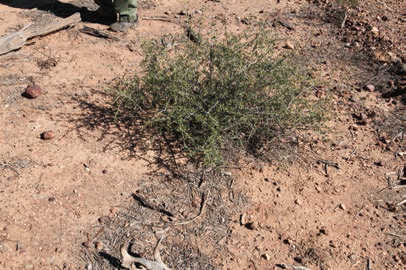
Stage 1 — a prickly shrub.
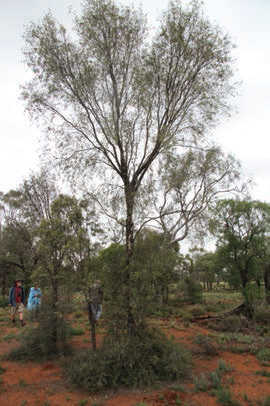
Stage 3 — a tree emerges.
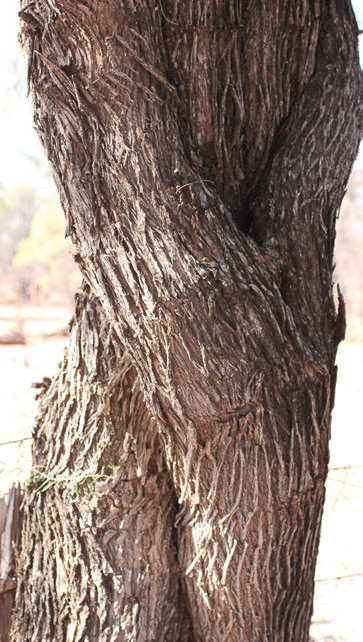
Stage 2 of the life of the supplejack. |

Stage 2 — a branch arises
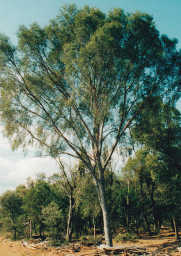
Stage 4 — a tree emerges.
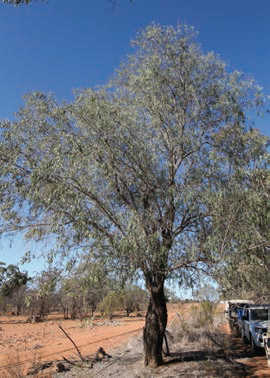
Into stage 3 — as a tree. |
Thursday, September 15 and Friday, September 16
Wood and Craft Auction
Once again, David Munzberg and his team managed
to create the most incredible illusion, as he seamlessly
extracted the dollars from all of our pockets in
exchange for a handful of woody dreams — and
amazingly after morning tea, lunch, and afternoon
tea on the first day, he continued on the second day
to weave his magic, and finally, painlessly, extract a
little over AU$9,000 from the innocent souls under
his spell. All the participants were amazed and with
smiling faces, lovingly collected their spoils, in the
form of mostly tiny pieces of wood, which they
whisked away to their designated places of residence
— in many instances, thousands of kilometres from
whence the acts of illusion were performed.
What an amazing feat to accomplish, and one which
will provide its reward in enabling this group of
dedicated dreamers to return on yet another occasion
in the future, to accommodate even more dreams.
But, could it possibly be said that I am getting carried
away by sentiment? No — not so. For we are a group
of seriously intentioned individuals, male and female,
who, without trepidation, return time and time again,
to renew our hope that one day we will find our
personal novena! Say no more.
Unfortunately, the clouds rolled in for the planned
viewing of the heavenly gathering on Thursday
evening at The Cosmos Centre. However, we were
suitably entertained by a film on the nature and
structure of the planets and all matter and manner of
things above and below.
Saturday, September 17 - Open Day
As mentioned in the introduction, we were welcomed
by the locals — including the Charleville Mayor and
local dignitaries — who showed amazing interest
in what we were doing, and for the town's local
authorities who 'opened the doors' to our acceptance
of holding the meeting in Charleville. I am sure
that this was a major reason that members of the
Charleville community turned up on the Open Day.
In Summing Up
I would have to say that since Robin and I joined IWCS
this meeting has been one of the meetings of greatest
interest we have ever attended, — and that includes eight
other International Annual Meetings in Australia, Canada,
United States, The Netherlands, South Africa, and New
Zealand.
We were also pleased to welcome overseas visitors,
including Alan Curtis, Don Lown, Jean Sumner and Chuck
Ray from the USA, Bob and Ankie Goddard from the UK,
and Graham and Judith Trost from NZ, as well as members
from the other states, including Victoria, South Australia,
and Charles and Lalleen Broadbent, who came the long
way, around from Western Australia.
|
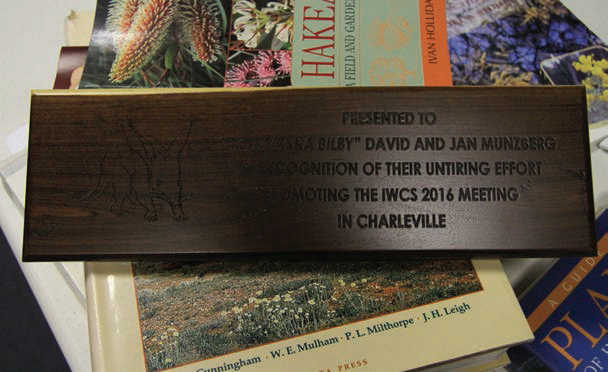
Commemorative plaque presented to David and Jan Munzberg for inventing Boyakka Bilby.
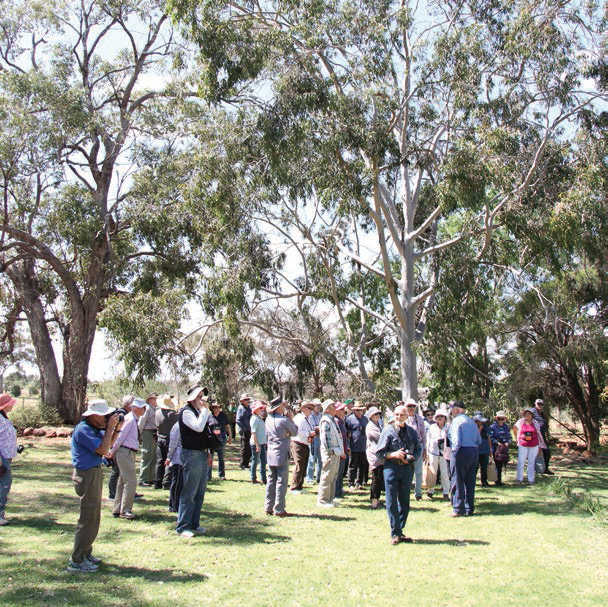
Group photo on the front lawn at Maryvale Station.
The highlight however has been the display of species and
craft which would have numbered around 4,000 items on
display and for sale to members and visitors at various
times — and, it's not very often that this translates to the
community. In fact, Colin Martin relayed to me that on
his visit to the local butcher following the meeting, and
during conversation about the meeting — the butcher said
to Colin, that, "For the week of the conference, I had the
biggest weekly 'till' taking that I have had for a long time,
because of the BBQs and dinners, and lunches, etc. that you
blokes had." The local newspaper sent representatives to
cover several of our activities, and the press and local radio
chipped in as well. That's all good news for IWCS and for
the town of Charleville.
Overall, the greatest thanks must go to Harry and the
members of the organising committee who have put such a
huge amount of work into this meeting over a long period.
Congratulations from all of us for creating such a
successful meeting.
|
|